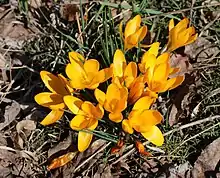| Crocus flavus | |
|---|---|
 | |
| Scientific classification | |
| Kingdom: | Plantae |
| Clade: | Tracheophytes |
| Clade: | Angiosperms |
| Clade: | Monocots |
| Order: | Asparagales |
| Family: | Iridaceae |
| Genus: | Crocus |
| Species: | C. flavus |
| Binomial name | |
| Crocus flavus | |
| Synonyms[2] | |
| |
Crocus flavus, known as yellow crocus,[3] Dutch yellow crocus or snow crocus,[4] is a species of flowering plant in the genus Crocus of the family Iridaceae. It grows wild on the slopes of Greece, former Yugoslavia, Bulgaria, Romania and northwestern Turkey,[1] with fragrant bright orange-yellow flowers. It is a small crocus (5–6 cm (2–2 in), despite the names of some cultivars, compared to the giant Dutch crocuses (C. vernus). Its cultivars are used as ornamental plants.
The Latin specific epithet flavus means "yellow".[5]
Description
Crocus flavus is a herbaceous perennial geophyte growing from a corm. The globe shaped corms are relatively large for a crocus species, and the tunics have parallel fibers.[6] The chromosome count is 2N=8 with 11 B-chromosomes.[7]
- Subspecies[1]
- Crocus flavus subsp. dissectus T.Baytop & B.Mathew - western Turkey
- Crocus flavus subsp. flavus - Greece, Turkey, Balkans; naturalized in Utah
- Crocus flavus subsp. sarichinarensis Rukšans - Turkey
Crocus flavus subsp. flavus has gained the Royal Horticultural Society's Award of Garden Merit.[8]
Cultivation
Crocus flavus naturalizes well in gardens, and has escaped cultivation and become naturalized in the US state of Arkansas.[9] The majority of plants grown in gardens are triploids that do not produce seeds and are propagated vegetatively.[6] The species has been hybridized with other crocus species to produce a number of other cultivars.[4]
Cultivars include Crocus flavus 'Grosser Gelber' ('Big Yellow'), with large orange-yellow flowers.[6]
 Illustration from Deutschlands Flora in Abbildungen
Illustration from Deutschlands Flora in Abbildungen_(6049519480).jpg.webp) Illustration by Margaret Roscoe
Illustration by Margaret Roscoe Crocus flavus subsp. flavus
Crocus flavus subsp. flavus
References
- 1 2 3 "Crocus flavus". World Checklist of Selected Plant Families. Royal Botanic Gardens, Kew. Retrieved 2013-09-21.
- ↑ "Crocus flavus subsp. flavus". World Checklist of Selected Plant Families. Royal Botanic Gardens, Kew. Retrieved 2016-01-07.
- ↑ BSBI List 2007 (xls). Botanical Society of Britain and Ireland. Archived from the original (xls) on 2015-06-26. Retrieved 2014-10-17.
- 1 2 Penner, Lyndon (2014-04-08). The Prairie Short Season Yard: Quick and Beautiful on the Canadian Prairies. Brush Education. ISBN 978-1-55059-543-7.
- ↑ Karkov, Catherine E.; Brown, George Hardin (2003-09-25). Anglo-Saxon Styles. SUNY Press. ISBN 978-0-7914-5869-3.
- 1 2 3 Jelitto, Leo (1990). Hardy herbaceous perennials. Wilhelm Schacht, Michael E. Epp, John Philip Baumgardt, Alfred Fessler. Portland, Or.: Timber Press. p. 170. ISBN 0-88192-159-9. OCLC 20012412.
- ↑ Brighton, C. A.; Mathew, B.; Marchant, C. J. (1973). "Chromosome Counts in the Genus Crocus (Iridaceae)". Kew Bulletin. 28 (3): 451–464. doi:10.2307/4108890. ISSN 0075-5974. JSTOR 4108890.
- ↑ "RHS Plant Selector - Crocus flavus subsp. flavus". Retrieved 15 April 2020.
- ↑ Serviss, Brett E.; Peck, James H.; Benjamin, Kristen R. (2016). "Crocus Flavus: A New Genus and Species of Non-Native Iridaceae for the Arkansas (U.s.a.) Flora". Journal of the Botanical Research Institute of Texas. 10 (2): 513–516. ISSN 1934-5259. JSTOR 44858594.
External links
- Ö zdemir, Canan. The Morphology and Anatomy of Crocus flavus Weston subsp. flavus (Iridaceae), Turk J Bot 30 (2006) 175-180
- ITIS
- Alpine Garden Society
- International Flower Bulb Centre
- Uniprot Taxonomy